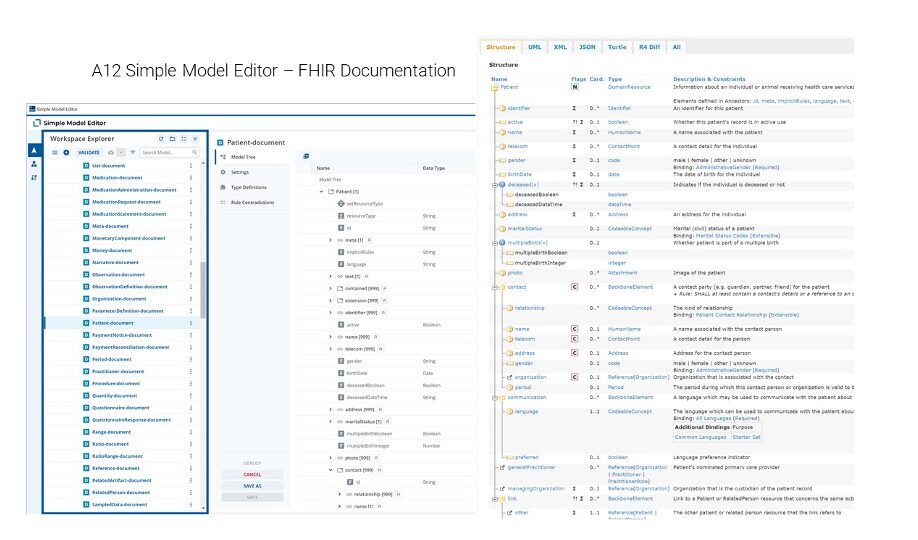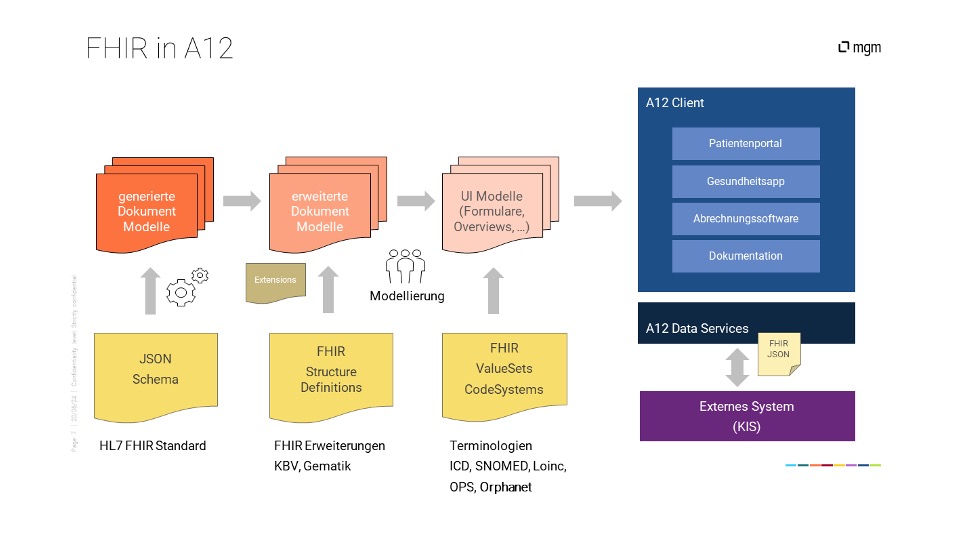Last Updated on 1. July 2024
The FHIR standard promotes interoperability between healthcare software systems. Integrating this standard into the A12 low-code platform revolutionizes healthcare application development. With A12’s modeling concept, medical professionals can design parts of the applications themselves.
FHIR (Fast Healthcare Interoperability Resources) transforms health informatics with its modern, flexible, and extendable structure tailored for electronic health data exchange. A12’s low-code platform enables quick application development with minimal programming effort. Integrating FHIR provides an ideal foundation for innovative healthcare solutions.
What is FHIR?
Developed by HL7 (Health Level Seven International), FHIR aims to enhance interoperability across different healthcare systems. It leverages modern web technologies like RESTful APIs, JSON, and XML to simplify health information exchange. FHIR defines numerous “resources” that represent core details about patients, treatments, diagnoses, and more. Alongside technical specifications, FHIR offers extensive documentation on healthcare processes and contexts, ensuring true interoperability through deep domain understanding.
Benefits of Integrating FHIR into A12
1. Faster Development:
FHIR integration allows developers to access standardized, interoperable health data without manually implementing extensive backend integrations.
2. Increased Interoperability:
FHIR resources facilitate seamless data exchange between various systems and applications.
3. Scalability and Flexibility:
Low-code platforms utilizing FHIR can scale and adapt to new requirements easily. FHIR’s modular structure enables selective use and expansion of necessary resources.
4. Accessibility and Usability:
Low-code platforms empower non-programmers, like medical staff, to develop or modify applications accessing FHIR data, fostering innovation and efficiency in healthcare.
Achieving FHIR Integration in A12
FHIR aims to cover 80% of healthcare needs globally, defining entities generically and extendably. FHIR structure definitions specify these entities for health systems or applications. From base resource definitions, A12 document models can be auto generated and used in application modeling to ensure interface compatibility with other healthcare systems.
In Germany, organizations like KBV and Gematik publish FHIR structure definitions. These definitions can be used to derive more specific structures for applications through generators or manually via A12 modeling tools (Simple Model Editor, SME). This process allows adding information beyond the structure definitions, forming the basis for application modeling with A12 tools. Given FHIR’s comprehensive coverage of healthcare, numerous scenarios become feasible.
Additionally, FHIR-defined terminologies, such as those by Gematik and KBV for German healthcare, become usable in A12 applications. FHIR ValueSets define code sets for form entries, enhancing data precision.
Medical and laboratory questionnaires, like those provided by the LOINC standard via FHIR, can be imported into A12 as FHIR resources, transformed into A12 forms via a generator, and integrated into applications.
Because FHIR’s use primarily occurs at the modeling level, A12 Fullstack development faces no constraints. For instance, A12’s Data Distribution component supports offline apps for devices, while A12 Workflows facilitate complex processes.
Conclusion
Integrating FHIR with the A12 platform forms a powerful combination with the potential to transform healthcare. Using FHIR’s flexibility and interoperability with A12’s user-friendliness and rapid development capabilities, organizations can develop innovative, customized solutions that enhance patient care and operational efficiency. This synergy not only advances technology but also promotes patient-centered care. The benefits extend beyond technical interfacing, utilizing and directly representing the domain expertise inherent in the FHIR standard to avoid design errors in applications.









